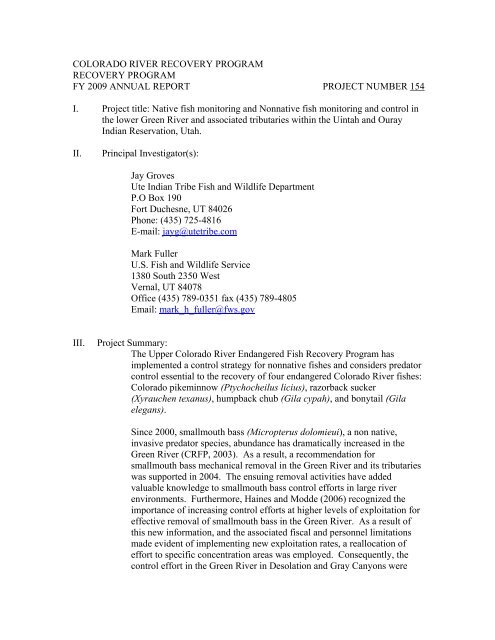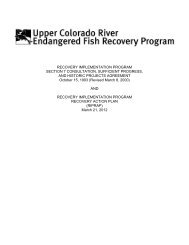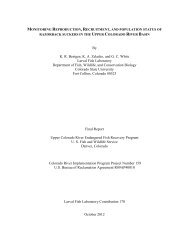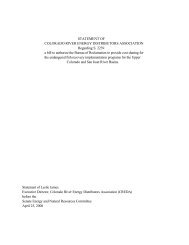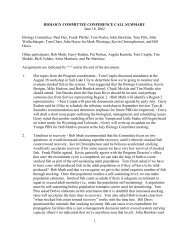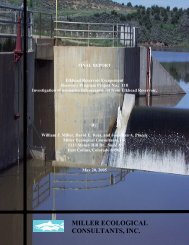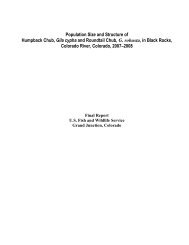Native fish monitor - Upper Colorado River Endangered Fish ...
Native fish monitor - Upper Colorado River Endangered Fish ...
Native fish monitor - Upper Colorado River Endangered Fish ...
You also want an ePaper? Increase the reach of your titles
YUMPU automatically turns print PDFs into web optimized ePapers that Google loves.
COLORADO RIVER RECOVERY PROGRAM<br />
RECOVERY PROGRAM<br />
FY 2009 ANNUAL REPORT PROJECT NUMBER 154<br />
I. Project title: <strong>Native</strong> <strong>fish</strong> <strong>monitor</strong>ing and Nonnative <strong>fish</strong> <strong>monitor</strong>ing and control in<br />
the lower Green <strong>River</strong> and associated tributaries within the Uintah and Ouray<br />
Indian Reservation, Utah.<br />
II.<br />
Principal Investigator(s):<br />
Jay Groves<br />
Ute Indian Tribe <strong>Fish</strong> and Wildlife Department<br />
P.O Box 190<br />
Fort Duchesne, UT 84026<br />
Phone: (435) 725-4816<br />
E-mail: jayg@utetribe.com<br />
Mark Fuller<br />
U.S. <strong>Fish</strong> and Wildlife Service<br />
1380 South 2350 West<br />
Vernal, UT 84078<br />
Office (435) 789-0351 fax (435) 789-4805<br />
Email: mark_h_fuller@fws.gov<br />
III.<br />
Project Summary:<br />
The <strong>Upper</strong> <strong>Colorado</strong> <strong>River</strong> <strong>Endangered</strong> <strong>Fish</strong> Recovery Program has<br />
implemented a control strategy for nonnative <strong>fish</strong>es and considers predator<br />
control essential to the recovery of four endangered <strong>Colorado</strong> <strong>River</strong> <strong>fish</strong>es:<br />
<strong>Colorado</strong> pikeminnow (Ptychocheilus licius), razorback sucker<br />
(Xyrauchen texanus), humpback chub (Gila cypah), and bonytail (Gila<br />
elegans).<br />
Since 2000, smallmouth bass (Micropterus dolomieui), a non native,<br />
invasive predator species, abundance has dramatically increased in the<br />
Green <strong>River</strong> (CRFP, 2003). As a result, a recommendation for<br />
smallmouth bass mechanical removal in the Green <strong>River</strong> and its tributaries<br />
was supported in 2004. The ensuing removal activities have added<br />
valuable knowledge to smallmouth bass control efforts in large river<br />
environments. Furthermore, Haines and Modde (2006) recognized the<br />
importance of increasing control efforts at higher levels of exploitation for<br />
effective removal of smallmouth bass in the Green <strong>River</strong>. As a result of<br />
this new information, and the associated fiscal and personnel limitations<br />
made evident of implementing new exploitation rates, a reallocation of<br />
effort to specific concentration areas was employed. Consequently, the<br />
control effort in the Green <strong>River</strong> in Desolation and Gray Canyons were
eallocated to the Echo Park/Split Mountain reach. Additionally, the non<br />
native <strong>fish</strong> control effort in the Duchesne <strong>River</strong> was abandoned in 2004<br />
because of intermittent flows.<br />
In recent history, Desolation Canyon has shown evidence of increased<br />
smallmouth bass population densities (Badame and Modde, personal<br />
communication, 2007). A realistic potential for re-established smallmouth<br />
bass populations or expansion of existing populations within the Uintah<br />
and Ouray Reservation merits <strong>monitor</strong>ing and/or control of smallmouth<br />
bass in the Green <strong>River</strong> and its tributaries (Duchesne and White <strong>River</strong>s).<br />
In 2008, sampling was reinitiated in the Green <strong>River</strong> (Desolation Canyon)<br />
and the Duchesne <strong>River</strong> to determine if Smallmouth bass catch rates<br />
warranted increased removal efforts. Catch rates (CPUE) of Smallmouth<br />
bass in Desolation Canyon were found to be relatively low; however,<br />
catch rates (CPUE) in the Duchesne <strong>River</strong> were higher than previous<br />
documentation. Removal efforts in 2009 were focused on the Duchesne<br />
<strong>River</strong>.<br />
The main objective of this project is to <strong>monitor</strong> and/or control Smallmouth<br />
bass populations in the lower Green <strong>River</strong> and its associated tributaries<br />
within the Ute Indian Tribe, Uintah and Ouray Reservation.<br />
A secondary objective is to identify the native <strong>fish</strong> community<br />
composition at lower flows within the Duchesne <strong>River</strong>. Sampling methods<br />
that may be employed in this study may include continuous raft electro<strong>fish</strong>ing,<br />
backpack electro-<strong>fish</strong>ing, canoe/barge electro-<strong>fish</strong>ing and electric<br />
seining.<br />
IV.<br />
Study Schedule:<br />
a: Initial year: FY09<br />
b: Final year: FY09<br />
V. Relationship to RIPRAP:<br />
GENERAL RECOVERY PROGRAM SUPPORT ACTION PLAN<br />
III. Reduce negative impacts of nonnative <strong>fish</strong>es and sport<strong>fish</strong><br />
management activities (nonnative and sport<strong>fish</strong> management).<br />
III.A. Reduce negative interactions between nonnative and endangered<br />
<strong>fish</strong>es.<br />
III.A.2. Identify and implement viable active control measures.<br />
GREEN RIVER ACTION PLAN: MAINSTEM<br />
I. Reduce impacts of nonnative <strong>fish</strong>es and sport<strong>fish</strong> management<br />
activities (nonnative and sport<strong>fish</strong> management).
III.A. Reduce negative impacts to endangered <strong>fish</strong>es from sport<strong>fish</strong><br />
management activities.<br />
III.A.4. Develop and implement control programs for nonnative <strong>fish</strong>es in<br />
river reaches occupied by the endangered <strong>fish</strong>es to identify<br />
Required levels of control. Each control activity will be evaluated<br />
for effectiveness, and then continued as needed.<br />
III.b.3. (Nonnative <strong>fish</strong> removal in Yampa Canyon).<br />
VI.<br />
FY09 Accomplishments, Tasks and Deliverables, Initial<br />
Findings, Shortcomings and Discussion:<br />
Task 1.<br />
Duchesne <strong>River</strong> – High Flow – Non <strong>Native</strong> <strong>Fish</strong> Monitoring<br />
Study Design<br />
The Duchesne <strong>River</strong> non native <strong>monitor</strong>ing pass consist of 42 RM, from Myton<br />
Bridge to the confluence with the Green <strong>River</strong>. For data analysis, the stream<br />
segment was divided into 2 reaches, each possessing distinct and varying habitat<br />
types, i.e., riffles, runs, pools, backwaters. Reach 1 consist of 25 RM, from<br />
Myton, Utah to Randlett, Utah; while Reach 2 consist of 17 RM, from Randlett,<br />
Utah to the confluence with the Green <strong>River</strong>. The Duchesne <strong>River</strong> non native<br />
<strong>monitor</strong>ing pass was performed on at various times during June 2009 as a<br />
cooperative effort between the Ute Indian Tribe <strong>Fish</strong> and Wildlife Department<br />
(UIT F&WD) and the US <strong>Fish</strong> and Wildlife Service (FWS) and the Utah Division<br />
of Wildlife Resources (UDWR). The species of study were smallmouth bass and<br />
any non native <strong>fish</strong> species that occupy the Duchesne <strong>River</strong>. Additionally, for the<br />
purpose of data analysis, <strong>fish</strong> surveyed were determined to be within two distinct<br />
groups, either juvenile (
Illustration 1. Duchesne <strong>River</strong> Total Non <strong>Native</strong> Species Distribution<br />
Non <strong>Native</strong> <strong>Fish</strong> Distribution<br />
Black Bullhead<br />
Black Crappie<br />
Hybrid Sucker<br />
Brown Trout<br />
Channel Cat<strong>fish</strong><br />
Fathead Minnow<br />
Green Sun<strong>fish</strong><br />
Mottled Sculpin<br />
Rainbow Trout<br />
Red Shiner<br />
Smallmouth Bass<br />
Sand Shiner<br />
White Sucker<br />
Illustration 1 demonstrates the distribution for all <strong>fish</strong> from Myton, Utah (RM 42)<br />
to the Green <strong>River</strong> confluence (RM0) in 2009. Smallmouth bass, Channel cat<strong>fish</strong><br />
and White sucker dominate the distribution with 39%, 31% and 15% of the<br />
observed non native <strong>fish</strong>es, respectively.<br />
Smallmouth Bass CPUE and Length Frequency<br />
Both Smallmouth bass juvenile and adult densities were similar values in 2009,<br />
with adult densities slightly higher. CPUE values demonstrated below are from<br />
the entire stream segment (42RM).<br />
Illustration 2. Duchesne <strong>River</strong> CPUE (SMB)<br />
SMB CPUE 2009<br />
9.0000<br />
8.0000<br />
7.0000<br />
6.0000<br />
5.0000<br />
4.0000<br />
3.0000<br />
2.0000<br />
1.0000<br />
0.0000<br />
8.0478<br />
3.8334 4.2382<br />
2009 SMB CPUE<br />
200mm<br />
The majority of Smallmouth bass surveyed in 2009 were within the distribution<br />
range of 100mm to 300mm. (Illustration 3).
Illustration 3. Duchesne <strong>River</strong> Percent Length Frequency (SMB)<br />
SMB Length Distribution<br />
%<br />
18<br />
16<br />
14<br />
12<br />
10<br />
8<br />
6<br />
4<br />
2<br />
0<br />
25 50 75 100 125 150 175 200 225 250 275 300 325 350 375 400 425 450 475<br />
Total Length<br />
Smallmouth Bass CPUE and Length Frequency Comparison<br />
Overall, the CPUE comparison data implies that total Smallmouth bass densities<br />
were greater in 2008 than in 2009 (Illustration 4). Smallmouth bass juvenile<br />
densities were higher in 2008 than in 2009; however, in 2009 adult Smallmouth<br />
bass densities were higher. The higher CPUE values for both overall and juvenile<br />
Smallmouth bass, in 2008 and the higher value for adult Smallmouth bass in 2009<br />
may be a result of Duchesne <strong>River</strong> flows during the surveys. The higher values<br />
were surveyed in much lower flows in 2008.<br />
Illustration 4. Duchesne <strong>River</strong> CPUE Comparison (SMB)<br />
SMB CPUE 2008 v 2009<br />
15<br />
10<br />
5<br />
0<br />
1 2<br />
Total 12.90119243 8.0478<br />
200mm 3.741904298 4.2382<br />
2008 2009<br />
In a comparison with 2008 percent length frequency (Illustration 5), the analysis<br />
indicates that the Percent Length Distribution for each year is similar; however, a<br />
noticeable peak is illustrated with maturing juveniles within the 2009 data set.
Illustration 5. Duchesne <strong>River</strong> Percent Length Frequency 2008 v 2009<br />
SMB Length Distribution Comparision '08 v '09<br />
30<br />
25<br />
%<br />
20<br />
15<br />
10<br />
2009<br />
2008<br />
5<br />
0<br />
25 50 75 100 125 150 175 200 225 250 275 300 325 350 375 400 425 450 475<br />
Total Lenth<br />
Smallmouth Bass Discussion<br />
In a comparison of 2008 and 2009 Duchesne <strong>River</strong> Smallmouth bass <strong>monitor</strong>ing<br />
data (Illustration 6), it is evident that the calculated CPUE for the entire stream<br />
segment are much higher for 2008 values of smallmouth bass occupying the<br />
Duchesne <strong>River</strong>. As mentioned above, there may be a variety of factors that may<br />
contribute to the increase in abundance of non native species, including variable<br />
seasonal and annual flows and seasonal survey schedules. It is evident by these<br />
affecting factors, that additional <strong>monitor</strong>ing is warranted on the Duchesne <strong>River</strong>.<br />
Illustration 6. Duchesne <strong>River</strong> SMB CPU Comparison<br />
CPUE Comparison 2008 v 2009<br />
50.00<br />
40.00<br />
30.00<br />
20.00<br />
10.00<br />
0.00<br />
2008 CPUE 2009 CPUE<br />
Task 2.<br />
Duchesne <strong>River</strong> – High Flow –<strong>Native</strong> <strong>Fish</strong> Community Composition<br />
Study Design<br />
The Duchesne <strong>River</strong> native <strong>fish</strong> community composition pass consists of a 42 RM<br />
stream segment, from Myton Bridge to the confluence with the Green <strong>River</strong>. For<br />
data analysis, the stream segment was divided into eight (8) Designated Miles.<br />
Each Designated Mile is a one (1RM) mile reach, each possessing distinct and
varying habitat types, i.e., riffles, runs, pools, backwaters. Each reach was<br />
established at an equal distance (5RM) from each other, originating at the<br />
confluence with the Green <strong>River</strong> (RM 0) to <strong>River</strong> Mile 40. The Duchesne <strong>River</strong><br />
native <strong>fish</strong> community composition pass was performed at various times during<br />
June 2009 as a cooperative effort between the Ute Indian Tribe <strong>Fish</strong> and Wildlife<br />
Department (UIT F&WD) and the US <strong>Fish</strong> and Wildlife Service (FWS) and the<br />
Utah Division of Wildlife Resources (UDWR). The species of study were all<br />
native <strong>fish</strong> species that occupy the Duchesne <strong>River</strong>.<br />
General Results<br />
Within each of the Designated Mile’s, a total of 13 native <strong>fish</strong>es were sampled,<br />
including Roundtail chub (Gila robusta), Razorback sucker (Xyrauchen texanus),<br />
Flannelmouth sucker (Catostomus latipinnis), and Bonytail (Gila elegans). Of the<br />
13 total observed native <strong>fish</strong>es, Flannelmouth sucker comprise the highest density<br />
of <strong>fish</strong> surveyed (Table 2, Illustration 7).<br />
Table 2. Duchesne <strong>River</strong> <strong>Native</strong> <strong>Fish</strong> Total Distribution (HF)<br />
RTC RZB FMS BTC Total<br />
1 3 8 1 13<br />
Illustration 7. Duchesne <strong>River</strong> High Flow Survey<br />
Duchesne <strong>River</strong> <strong>Native</strong> <strong>Fish</strong> Distribution<br />
Total #<br />
9<br />
8<br />
7<br />
6<br />
5<br />
4<br />
3<br />
2<br />
1<br />
0<br />
bonytail<br />
flannelmouth<br />
sucker<br />
roundtail chub<br />
razorback sucker<br />
<strong>Native</strong> <strong>Fish</strong> Community Composition Discussion<br />
The 2009 Duchesne <strong>River</strong> native <strong>fish</strong> community composition data demonstrates<br />
low numbers of native <strong>fish</strong> species that occupy the Duchesne <strong>River</strong>, within sub<br />
sampling reaches, during high flow events. CPUE values for Bonytail,<br />
Flannelmouth sucker, Roundtail chub and Razorback sucker are 0.076, 0.227,<br />
0.006 and 0.076, respectively (Illustration 8) for each Designated Mile.<br />
Additionally, CPUE calculated for each native <strong>fish</strong> species are well below a single<br />
(1) <strong>fish</strong> caught per hour. Of the 10 known native <strong>fish</strong> species that have historically<br />
occupied the Duchesne <strong>River</strong>, only four (4) were observed during the 2009 native<br />
<strong>fish</strong> community composition survey.
Illustration 8. Duchesne <strong>River</strong> <strong>Native</strong> <strong>Fish</strong> Community Composition (HF)<br />
Duchesne <strong>River</strong> <strong>Native</strong> <strong>Fish</strong> CPUE<br />
0.700<br />
0.600<br />
0.500<br />
0.400<br />
CPUE<br />
0.300<br />
0.200<br />
0.100<br />
0.000<br />
RTC RZB FMS BTC<br />
Task 3.<br />
Duchesne <strong>River</strong> – Low Flow –<strong>Native</strong> <strong>Fish</strong> Community Composition<br />
Study Design<br />
The Duchesne <strong>River</strong>, low flow, native <strong>fish</strong> community composition survey<br />
consists of a 42 RM stream segment, from Myton Bridge to the confluence with<br />
the Green <strong>River</strong>. For data analysis, the stream segment was divided into eight (8)<br />
Designated Miles. Each Designated Mile is a one (1RM) mile reach, each<br />
possessing distinct and varying habitat types, i.e., riffles, runs, pools, backwaters.<br />
Each reach was established at an equal distance (5RM) from each other,<br />
originating at the confluence with the Green <strong>River</strong> (RM 0) to <strong>River</strong> Mile 40. Each<br />
Designated Mile includes two (2) survey reaches. Each survey reach is<br />
approximately 400m in length and are located at random locations within each<br />
Designated Mile. The Duchesne <strong>River</strong>, low flow, native <strong>fish</strong> community<br />
composition survey was performed at various times from August through<br />
September, 2009 as a cooperative effort between the Ute Indian Tribe, <strong>Fish</strong> and<br />
Wildlife Department (UIT F&WD), the US <strong>Fish</strong> and Wildlife Service (FWS) and<br />
the Utah Division of Wildlife Resources (UDWR). The species of study were all<br />
native <strong>fish</strong> species that occupy the Duchesne <strong>River</strong>.<br />
General Results<br />
Within each of the Designated Mile’s, a total of 38 native <strong>fish</strong>es were observed,<br />
including Speckled dace (Rhinichthys osculus) and Flannelmouth sucker<br />
(Catostomus latipinnis). Of the 38 total observed native <strong>fish</strong>es, Speckled dace<br />
comprise the highest density of <strong>fish</strong> surveyed (Table 3, Illustration 9).<br />
Table 3. Duchesne <strong>River</strong> <strong>Native</strong> <strong>Fish</strong> Total Distribution (LF)<br />
SD FMS Total<br />
32 6 38
Illustration 9. Duchesne <strong>River</strong> Low Flow Survey<br />
Duchesne <strong>River</strong> <strong>Native</strong> <strong>Fish</strong><br />
Distribution<br />
Total #<br />
40<br />
30<br />
20<br />
10<br />
0<br />
Speckled Dace<br />
Flannelmouth<br />
Sucker<br />
<strong>Native</strong> <strong>Fish</strong> Community Composition Discussion<br />
The 2009 Duchesne <strong>River</strong> native <strong>fish</strong> community composition data demonstrates<br />
low numbers of native <strong>fish</strong> species that occupy the Duchesne <strong>River</strong>, within sub<br />
sampling reaches, during the low flow season. The CPUE for each Designated<br />
Mile, sampling reach, are relatively high in comparison to native <strong>fish</strong> CPUE<br />
(Illustration 10), there were a total of 1305 <strong>fish</strong> sampled with 38 being native <strong>fish</strong><br />
species. CPUE values for Speckled dace and Flannelmouth sucker are 12.35 and<br />
2.31, respectively (Illustration 11). Additionally, of the 10 known native <strong>fish</strong><br />
species that have historically occupied the Duchesne <strong>River</strong>, only two (2) were<br />
observed during the 2009, low flow, native <strong>fish</strong> community composition survey.<br />
Illustration 10. Duchesne <strong>River</strong> <strong>Native</strong> <strong>Fish</strong> Community Composition (LF)<br />
Duchesne <strong>River</strong><br />
Designated Mile CPUE<br />
200<br />
179 140<br />
150<br />
CPUE 100<br />
50<br />
11 8<br />
18 4 21 0<br />
0<br />
DM 1 DM2 DM 3 DM4 1 DM 5 DM6 D M 7 DM8
Illustration 11. Duchesne <strong>River</strong> <strong>Native</strong> <strong>Fish</strong> Composition Effort (LF)<br />
Duchesne <strong>River</strong> <strong>Native</strong> <strong>Fish</strong> CPUE<br />
15<br />
CPUE<br />
10<br />
5<br />
0<br />
Speckled 1Dace<br />
Flannelmouth 2 Sucker<br />
VII.<br />
Recommendations<br />
Task 1 Duchesne <strong>River</strong> – High Flow – Non <strong>Native</strong> <strong>Fish</strong> Monitoring<br />
1. We recommend continuing smallmouth bass control in rivers that<br />
occupy or border the Uintah and Ouray Indian Reservation with<br />
emphasis to reduce smallmouth bass numbers.<br />
2. We recommend extending the non native <strong>monitor</strong>ing to include the<br />
invasive predatory <strong>fish</strong> species: Channel cat<strong>fish</strong> (Ictalurus<br />
punctatus) and White sucker (Catostomus commersonii) in rivers<br />
that occupy or border the Uintah and Ouray Indian Reservation<br />
with emphasis to reduce invasive, predatory <strong>fish</strong> species’ numbers.<br />
Task 2 Duchesne <strong>River</strong> – High Flow –<strong>Native</strong> <strong>Fish</strong> Community Composition<br />
1. We recommend continuing the native <strong>fish</strong> community composition<br />
<strong>monitor</strong>ing in rivers that occupy or border the Uintah and Ouray<br />
Indian Reservation with emphasis to acquire native <strong>fish</strong><br />
community composition data in the Duchesne <strong>River</strong>.<br />
Task 3 Duchesne <strong>River</strong> – Low Flow –<strong>Native</strong> <strong>Fish</strong> Community Composition<br />
1. We recommend continuing the native <strong>fish</strong> community composition<br />
<strong>monitor</strong>ing in rivers that occupy or border the Uintah and Ouray<br />
Indian Reservation with emphasis on acquiring native <strong>fish</strong><br />
community composition data in the Duchesne <strong>River</strong>.<br />
VIII.<br />
IX.<br />
Project Status:<br />
Final Year: FY09<br />
FY 0 Budget Status:<br />
Total<br />
A. Funds Provided: 15,505<br />
B. Funds Expended: 15,505<br />
C. Difference: 0
D. Recovery Program funds spent for publication<br />
charges: $0<br />
X: Status of Data Submission:<br />
Data is being entered in dBASE files and will be submitted to the program<br />
data base manager upon completion in 2009.<br />
XI.<br />
References:<br />
Modde, T., and Fuller, F. 2002. Feasibility of channel cat<strong>fish</strong> reduction in the<br />
lower Yampa <strong>River</strong>. Final Report, Project 88. Submitted to the Recovery<br />
Implementation Program, U.S. <strong>Fish</strong> and Wildlife Service, Denver, CO.<br />
Tyus, H.M., and J.F. Saunders. 1996. Nonnative <strong>fish</strong>es in the upper <strong>Colorado</strong><br />
<strong>River</strong> basin and a strategic plan for their control. Final Report of<br />
University of <strong>Colorado</strong> Center for Limnology to <strong>Upper</strong> <strong>Colorado</strong> <strong>River</strong><br />
<strong>Endangered</strong> <strong>Fish</strong> Recovery Program, Denver, <strong>Colorado</strong>.<br />
Lentsch, L.D., R.T. Muth, P.d. Thompson, B.G Hoskins and T.A. Crowl. 1996.<br />
Options for selective control of nonnative <strong>fish</strong>es in the upper <strong>Colorado</strong><br />
<strong>River</strong> basin. Utah Division of Wildlife Resources Publication 96-14, Salt<br />
Lake City, Utah.


